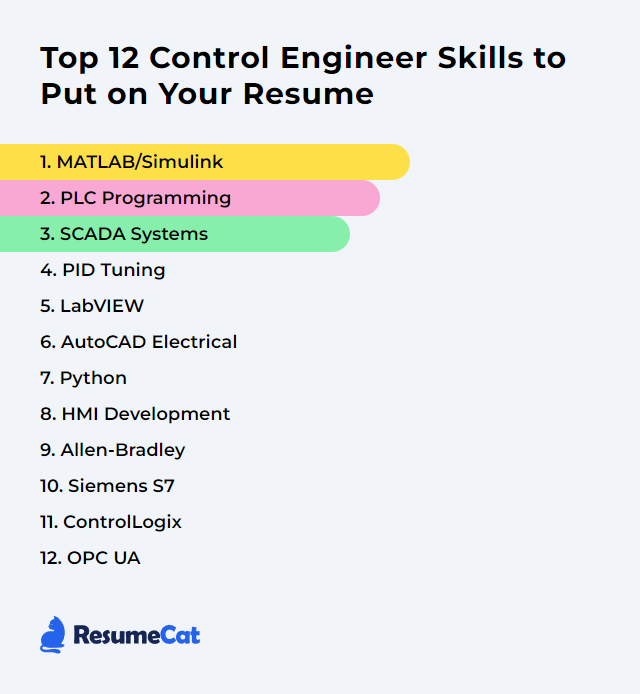Top 12 Control Engineer Skills to Put on Your Resume
In the fast-moving world of control engineering, the blend of sharp technical chops and thoughtful human skills is what moves the needle. The right toolkit doesn’t just land interviews; it makes projects calmer, safer, and faster. Below, the essential dozen—skills that punch above their weight on a resume and on the plant floor.
Control Engineer Skills
- MATLAB/Simulink
- PLC Programming
- SCADA Systems
- PID Tuning
- LabVIEW
- AutoCAD Electrical
- Python
- HMI Development
- Allen-Bradley
- Siemens S7
- ControlLogix
- OPC UA
1. MATLAB/Simulink
MATLAB/Simulink offers a powerful environment to design, simulate, and analyze dynamic systems. Block diagrams, scripted workflows, and rich toolboxes let you try ideas quickly, fail safely, and iterate your way to stable control strategies.
Why It's Important
Control design lives and breathes on models. MATLAB/Simulink makes it easy to build them, test edge cases, validate controllers, and move toward implementation with confidence—and speed.
How to Improve MATLAB/Simulink Skills
Level up by mixing fundamentals with practice:
Nail the basics: Matrix operations, scripting, function creation, and Simulink block semantics.
Use Control System and System Identification toolboxes: Model plants, fit real data, and design compensators without guesswork.
Explore Simulink Control Design: Frequency response estimation, PID tuning, and loop shaping in one flow.
Automate: Write scripts to parameter sweep, run Monte Carlo sims, and auto-generate reports.
Prototype fast, then harden: Start with simplified models; add nonlinearity, delays, and noise later.
Stay current: Track release notes and new features; adopt them when they shrink effort or risk.
Build small projects: Closed-loop temperature control, servo positioning, or DC motor speed—ship something that works.
Keep the loop tight: model, test, measure, refine.
How to Display MATLAB/Simulink Skills on Your Resume

2. PLC Programming
PLC programming builds the logic that runs factories—sequencing, interlocks, safety, diagnostics. Languages under IEC 61131-3 (Ladder, Function Block, Structured Text, and more) bring determinism to messy real processes.
Why It's Important
Industrial automation depends on PLCs for uptime, safety, and repeatability. Well-written logic cuts downtime, clarifies faults, and scales as lines grow.
How to Improve PLC Programming Skills
Deepen fundamentals: Scan cycles, task priorities, I/O mapping, debouncing, and state machines.
Master Ladder and Structured Text: Readability meets power; use each where it shines.
Design for faults: Timeouts, retries, safe states, latched alarms, and clear diagnostics.
Apply standards: Follow IEC 61131-3 concepts, naming conventions, and modular design.
Simulate first: Emulators and digital twins flush out logic bugs before commissioning.
Security and safety: Role-based access, change management, and safety PLC patterns where required.
Document relentlessly: Comment intent, not the obvious. Version control your projects.
Practice: Small projects—conveyors, mixers, batching. Scale up to complex cells.
How to Display PLC Programming Skills on Your Resume

3. SCADA Systems
SCADA platforms collect data, visualize states, alarm on trouble, and let operators steer sprawling processes from one pane of glass. Think telemetry, trends, and commands with strict governance.
Why It's Important
Visibility breeds control. SCADA improves throughput, reduces downtime, and helps teams act before problems cascade.
How to Improve SCADA Systems Skills
Harden security: Segmented networks, strong authentication, encrypted protocols, and patch discipline. Align with ISA/IEC 62443 practices.
Engineer for reliability: Redundant servers, failover clients, heartbeat checks, and watchdogs. Test switchover often.
Curate data: Normalize tags, set deadbands wisely, and build meaningful KPIs. Archive what matters; compress the rest.
Design clean HMIs: High-performance graphics, consistent color semantics, and alarm rationalization.
Modernize comms: Standard protocols (OPC UA, MQTT where appropriate), robust time sync, and managed switches.
Scale smart: Use historians, edge processing, and cloud extensions (e.g., major cloud IoT services) where latency and cost make sense.
Train operators: Drills, playbooks, and simulator time. People close the loop.
How to Display SCADA Systems Skills on Your Resume
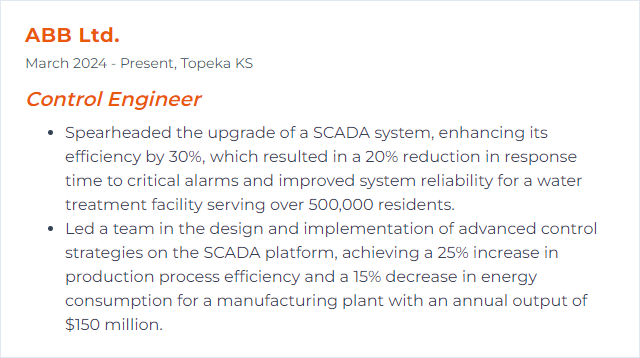
4. PID Tuning
PID tuning shapes how a system reacts—how fast it gets to setpoint, how much it overshoots, how it shrugs off disturbances. Good tuning feels invisible; bad tuning shouts.
Why It's Important
Right gains mean stability and efficiency. Energy saved, scrap reduced, valves spared, operators relieved.
How to Improve PID Tuning Skills
Characterize the plant: Dead time, time constants, nonlinearity. No model, no luck.
Pick a method: Ziegler–Nichols, Cohen–Coon, lambda tuning, relay auto-tune—choose to fit dynamics and objectives.
Start safe: Conservative gains first, then push bandwidth carefully.
Use metrics: IAE, ISE, settling time, overshoot, and control effort—quantify tradeoffs.
Simulate then field-test: Close the gap between model and reality; retune when conditions drift.
Add features when needed: Anti-windup, setpoint weighting, feedforward, and filters for noisy signals.
How to Display PID Tuning Skills on Your Resume
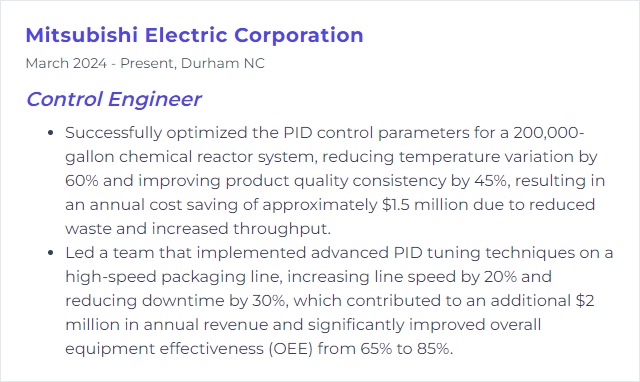
5. LabVIEW
LabVIEW’s graphical paradigm speeds up data acquisition, test automation, and rapid control prototyping. Wires and nodes, backed by drivers and toolkits, get hardware talking quickly.
Why It's Important
For test stands and embedded control pilots, LabVIEW shortens the distance from idea to running system—especially when instruments and DAQ are in the mix.
How to Improve LabVIEW Skills
Master core patterns: State machines, producer–consumer loops, and queued message handlers.
Use Control Design and Simulation: Model plants, simulate controllers, and iterate safely.
Organize projects: Libraries, classes, and clear dependency management to keep builds sane.
Leverage toolkits: Real-Time, FPGA, Vision, and Robotics when latency or hardware determinism matters.
Write testable code: Modular VIs, error clusters, logging, and unit tests.
Practice with hardware: NI DAQ, cRIO, and third-party instruments—drivers tell the real story.
How to Display LabVIEW Skills on Your Resume
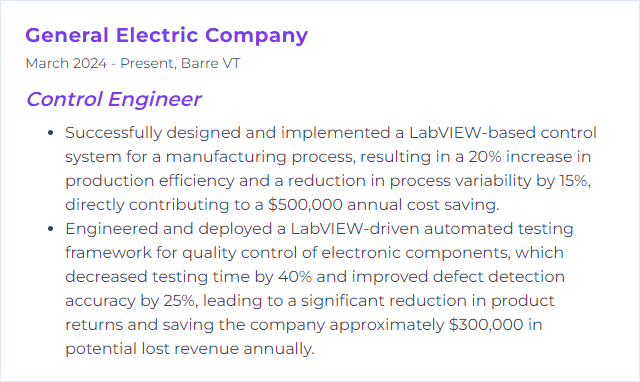
6. AutoCAD Electrical
AutoCAD Electrical streamlines schematics, panel layouts, and documentation. Symbols, tag management, and cross-references keep projects consistent—and checkable.
Why It's Important
Clean drawings reduce build errors, speed commissioning, and make maintenance less of a scavenger hunt.
How to Improve AutoCAD Electrical Skills
Template everything: Title blocks, layers, standards, and project properties dialed in from the start.
Exploit automation: Wire numbering, device tagging, cross-referencing, and report generation.
PLC I/O features: Import I/O lists, auto-generate cards, and align addressing with the control program.
Symbol libraries: Customize and enforce usage; keep a shared library under version control.
Panel layouts: Clearance, heat, cable routing, and manufacturer footprints verified early.
QA passes: Run error checks, resolve duplicates, and sync BOM with procurement.
How to Display AutoCAD Electrical Skills on Your Resume

7. Python
Python is the glue: data wrangling, simulation, optimization, and quick integrations. With libraries like NumPy, SciPy, Matplotlib, pandas, and the Python Control Systems Library, it turns raw numbers into decisions.
Why It's Important
From modeling to report automation, Python trims manual effort and opens doors to analytics and machine learning when the process demands extra brains.
How to Improve Python Skills
Strengthen fundamentals: Functions, classes, packaging, virtual environments, and testing.
Focus on control work: State-space modeling, signal processing, optimization, and numerical methods.
Visualize clearly: Consistent plotting, dashboards, and exports that explain themselves.
Use notebooks wisely: Exploratory work in Jupyter; move stable code into modules.
Automate the boring parts: Parsing logs, generating compliance reports, batch simulations.
Build projects: Parameter identification, MPC prototypes, digital twin utilities—small tools with sharp edges.
How to Display Python Skills on Your Resume
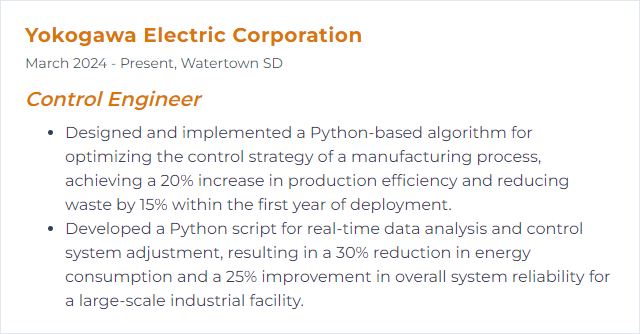
8. HMI Development
HMI development turns complexity into clarity. Operators need signal, not noise—layouts that highlight the abnormal and make action obvious.
Why It's Important
Good HMIs reduce mistakes and response time. They also lower training overhead and keep shifts humming when things get weird.
How to Improve HMI Development Skills
Start with users: Walk the process. Map tasks, pain points, and failure modes. Design to their reality.
Adopt high-performance graphics: Muted palettes, meaningful color, clear trends, and alarm hierarchies.
Design for scale: Consistent navigation, reusable templates, and standards that survive change.
Exploit feedback: Immediate confirmations, progress indicators, and graceful error messages.
Build for safety and security: Role-based access, command confirmations, and audit trails.
Test, then test again: Usability sessions, scenario drills, and post-incident reviews that feed back into design.
How to Display HMI Development Skills on Your Resume
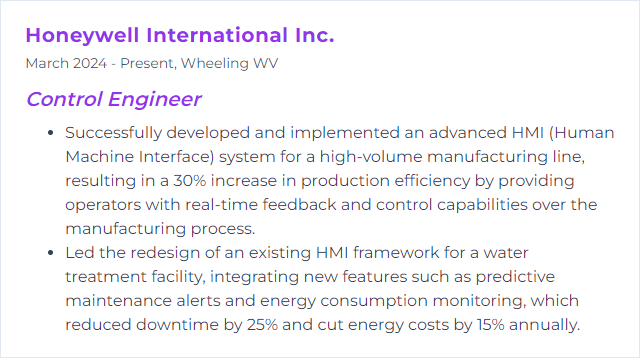
9. Allen-Bradley
Allen-Bradley (Rockwell Automation) covers the spectrum: PLCs, PACs, HMIs, drives, and safety hardware. A common ecosystem, tight integrations, and broad industry adoption make it a safe bet for complex plants.
Why It's Important
From ControlLogix to CompactLogix, from PanelView to intelligent drives, the platform scales and supports long-lived industrial systems with solid tooling and lifecycle support.
How to Improve Allen-Bradley Skills
Know the lineup: ControlLogix and CompactLogix controllers, I/O families, safety modules, and drives.
Master Studio 5000 Logix Designer: Ladder, Structured Text, Function Block, UDTs, AOIs, and Produced/Consumed Tags.
Use Connected Components Workbench: For Micro800 and component-class devices—great for cost-sensitive cells.
Simulate first: Logix Emulate for offline testing and commissioning prep.
Document and version: Enforce naming, revision notes, and backups. Keep firmware and project versions aligned.
Troubleshoot efficiently: Trend tools, cross-references, force management, and diagnostics discipline.
How to Display Allen-Bradley Skills on Your Resume
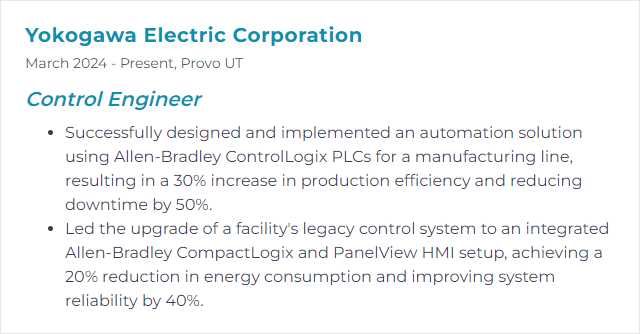
10. Siemens S7
Siemens S7 PLCs power automation across industries, with scalable CPUs and tight integration through TIA Portal for configuration, programming, and diagnostics.
Why It's Important
Reliable hardware, broad module support, and a cohesive engineering environment make S7 a mainstay in global plants.
How to Improve Siemens S7 Skills
Work inside TIA Portal: Hardware config, device commissioning, tag management, and online diagnostics.
Write efficient code: Optimize OB/FB/FC structure, reduce cycle times, and manage data blocks cleanly.
Network wisely: Solid PROFINET design, time sync, and determinism where motion or safety demands it.
Keep firmware aligned: Match CPU and module firmware to project versions; track changes.
Leverage libraries: Reusable blocks, tested templates, and consistent naming conventions.
Monitor performance: Use diagnostic buffers, trace tools, and load monitoring to tune the system.
How to Display Siemens S7 Skills on Your Resume
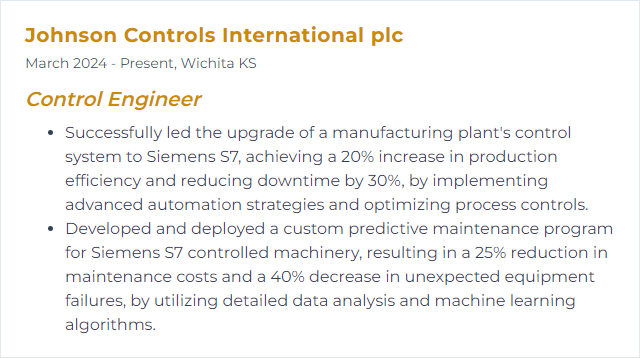
11. ControlLogix
ControlLogix is Rockwell Automation’s flagship PAC platform: modular, fast, and built for large, integrated systems with demanding communication needs.
Why It's Important
It anchors complex cells and lines with robust networking, motion, and safety options—plus tooling that supports big teams and long lifecycles.
How to Improve ControlLogix Skills
Stay current: Keep controller, module, and software versions compatible and supported.
Optimize logic: Trim scan time by restructuring routines, minimizing branching, and using UDTs and AOIs.
Engineer the network: Managed switches, VLANs, QoS, and clear traffic priorities for I/O, HMI, and motion.
Upgrade strategically: Newer CPUs, faster backplanes, and modern I/O reduce latency and extend service life.
Preventive maintenance: Health checks, backups, trending of key diagnostics, and spares planning.
Use advanced features: Produced/Consumed Tags, Add-On Profiles, and safety architectures where required.
How to Display ControlLogix Skills on Your Resume

12. OPC UA
OPC UA is the vendor-neutral backbone for industrial data—secure, structured, and built for interoperability from sensors to cloud.
Why It's Important
It standardizes how systems talk, cutting integration friction and enabling scalable data flows for analytics, MES, and beyond.
How to Improve OPC UA Skills
Harden security: Certificates, user roles, modern encryption policies, and disciplined patching.
Model data well: Use consistent namespaces and companion specifications that reflect your domain.
Tune performance: Right sampling intervals, publish rates, and payload sizes. Keep latency in check.
Adopt PubSub when needed: For scalable distribution and near real-time behavior, especially with UDP or MQTT.
Plan the network: Time synchronization and, where appropriate, Time Sensitive Networking for determinism.
Test interoperability: Validate clients and servers early; bake conformance checks into commissioning.
How to Display OPC UA Skills on Your Resume

